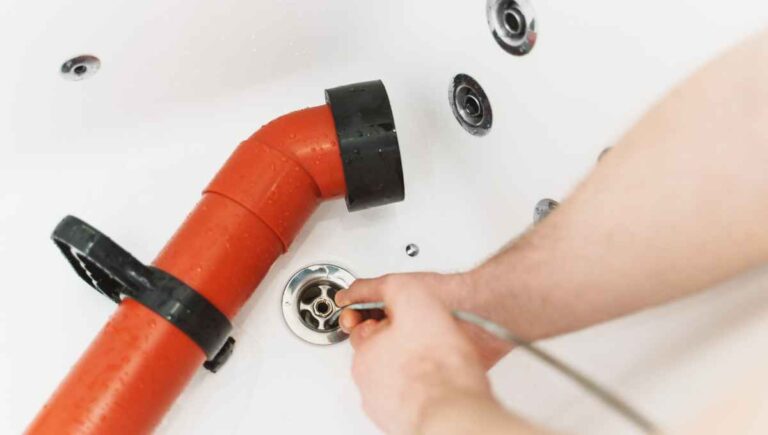Can You Move a Bathtub? (We Cover Everything Involved)

Moving a bathtub seems like a massive project to undertake. But, anything is possible when you put your mind to it, right? In this case, a little professional help may make it more possible. Either way, is it even possible to move a bathtub?
Moving a bathtub is possible, but not an easy task. It can involve changing the structure of your walls and electric wiring. Sometimes, it may even include rerouting your plumbing all while following local building codes.
Yet, it’s intimidating to not be able to understand all the changes that your bathroom might need if something is wrong, or if you’re simply not satisfied with the way it looks.
So, in this article, we will disclose whether moving a bathtub is possible or not, what is the proper way to do it, and the costs that you have to be prepared for if you decide to do it.
This post contains affiliate links. This means Household Blogger may earn a commission should you make a purchase using any of our links. Please refer to our full affiliate disclosure policy for full details.
Here’s a Quick Pro Tip!
Whether you want to move an existing tub or create a new location for a brand-new tub, it is possible to move the tub with the right knowledge.
Here are some shiny-new tubs to get you inspired:
1. Woodbridge Black Bathtub – Add a little class to your bathroom with this unique matte black tub.
2. Woodbridge Freestanding Bathtub – A luxurious option for your renovation.
3. Decoraport Clawfoot Bathtub – Everyone’s favorite clawfoot tub!
Is It Possible to Move a Bathtub?
Before you start dreaming up your ideal bathroom, let’s dig into the possibility of moving a bathtub.
Can You Put a Bathtub Anywhere?
You cannot just put a bathtub anywhere. Bathtubs come in different forms, and the way to categorize them is by their installation methods. The way that you should place your bathtub in a bathroom space will be determined by the installation method they require, which can be cheap or costly.
For example, you have to consider how waterproof your bathroom space is if you decide to install a freestanding tub, which you can put anywhere as long as you take the proper safety measures and consider your county’s building codes.
But, if you were to install an alcove tub, then you wouldn’t have much freedom in terms of where to place it because, as the name states, they should be placed in an alcove.
These types of bathtubs are common because of how convenient they are at guaranteeing bathroom space.
There are also other types of bathtubs. For instance, we’ve got drop-in bathtubs and under-mount bathtubs.
They’re both similar, as they’re designed to help you sink in the bathtub for as long as you’d seem fit, but they’re more expensive and harder to install.
For smaller spaces, there are options for corner bathtubs. Yet, you have to consider whether or not all the members of your household fit in them, since they’re smaller than the average bathtub.
Oftentimes, installing a bathtub will require you to build a wetroom, which is more convenient for people with mobility issues.
There are many designs online that you can choose from, but you must keep in mind the proper safety measures to avoid slippery situations.
Can You Rearrange a Bathroom?
With proper planning, you can rearrange your bathroom the way that you want to as long as it’s compliant with the building requirements of your city. For these purposes, it’s important to know the correct dimensions that your bathroom needs to have.
Your bathroom should be plumbing-accessible, safe, and flood-free. These three characteristics should be present in every bathroom because they can help keep the safety of your household.
Besides, you must prepare mentally for an extensive period of work. Your bathroom may need structural, electrical and plumbing changes that can help it function better.
And, these changes have a high chance of requiring a building permit.
Of course, all of that comes with big expenses, so you must prepare a solid budget before beginning the actual work.
Talk to a contractor, a plumber, or any professional with the proper expertise that can help you make the best decision.
You might also enjoy our post on If Bathtubs Have a Weight Limit
Can You Put a Tub Where a Shower Was?
Having a tub-shower combo is convenient for when you want to make your bathroom design simple. However, the ability to do it depends on the type of tub that you wish to install and how waterproof the shower area is.
If you want to install an under-mount tub, you can’t include it where your shower is because it’s too complex to waterproof the tiles.
But, if you have a wet room, you can do it. In fact, it’s easier to do so in such spaces. You can also do it with alcove tubs, as is the common way to install them nowadays.
In some cases, you might need to demolish the entire shower area for you to be able to do it.
And all of these changes will require you to contact a professional who can give you better clarity regarding what you want to do.
Is It Difficult to Move a Tub Drain?
Moving a tub drain requires you to follow a series of steps that need to be done carefully so that nothing provokes an accident or malfunction. The best thing you can do on this occasion is to call a plumber and get proper advice from a professional.
You may need to buy new plumbing materials to make sure to move your tub drain efficiently.
It’s a tedious task that you shouldn’t do on your own, so you should rely on a professional that can help you do this better.
Do I Have to Move the Plumbing if I Increase the Size of My Bathtub?
If you increase the size of your bathtub, surely you are thinking of replacing the old one with a new one. The way that your plumbing will connect to it will vary depending on the position of the new bathtub, and the type of installation method it requires.
A professional will tell you whether they need to modify the plumbing or not depending on the way your tub needs to be installed.
In some instances, the wall structure needs to be considered when deciding to change the plumbing structure.
Changing everything might be a huge expense. We can’t say that in all these cases you need to move your plumbing because it can depend on things like:
- Your bathroom space
- How your plumbing works and how it was originally installed
- How this will change the water intake of your bathroom
Do I Need a Building Permit to Move My Bathtub?
Some changes to your bathroom may trigger a permit that you need to retrieve from your city’s official website or office. However, some changes don’t require this permit because they remain merely aesthetical and not something to be concerned about.
Sit, and think for a moment: does your project require you to break a wall to change the plumbing or any other area that relates to your plumbing?
If so, there is a high chance that you may need to have a building permit.
The best thing you can do is to check your city’s official webpage for the building codes that apply in your area so that you avoid violating them.
Doing that will help you safeguard yourself from possible sanctions.
Do You Need a Permit to Renovate a Bathroom?
Renovating a bathroom can take various scopes of work. Because of this, making changes to it likely triggers a building permit. For better knowledge of the situation, you should hire a contractor that gives you an idea about what you need.
These changes require a permit:
- Adding or moving a sink
- Structural changes and other additions
- Plumbing and sewage projects
- Projects that require a dumpster (for demolition purposes)
- Replacing a water heater
- Adding windows
- Adding skylights
- Adding a new outlet to your house
- Installing tiles
- Replacing a bathtub
If you plan to renovate your bathroom, know that you can retrieve a permit online. Of course, you’d have to pay a fee.
If you hire a contractor, they usually do this for you, but you should still double-check to avoid conflicts and misunderstandings.
You might also enjoy our post on How Much it Costs to Move a Toilet
How to Move a Bathtub
Now that you know that you can move your bathtub (yay!) you must know the right way to do it. This will save you from personal injuries and additional costs if you break something, other than your bones!
How Do You Move a Bathtub?
You must consult with a professional that can guide you in the steps you need to be able to move your bathtub. You have to make sure to understand how the plumbing of a bathtub works, and this way, avoid making mistakes that could result in malfunctions.
Depending on the type of bathtub that you have, most of the moving isn’t something you can simply do by pushing or lifting a bathtub.
It may require moving the plumbing around your bathtub – don’t forget to turn off the water! – while considering the rough-in measurements it needs.
If you have an alcove tub, moving it is not so accessible because of how limiting the installation method is. However, moving a freestanding tub is not as complicated.
You should consider asking a professional about moving the drain and shower head if you have one.
How Do You Move Plumbing Around a Bathtub?
To be able to move the plumbing around the bathtub, you must understand how it is distributed in order to be able to change it. There are many pipe connections to a bathtub to be considered before starting to work, as they are essential to its functioning.
The plumbing around your bathroom consists of:
- Water supply lines – Supplies water to your bathtub. Helps you switch between hot and cold temperatures.
- Diverter pipes – To allow switching between the tub faucet and showerhead.
- Shut off valves – Helps control the house’s water supply.
- Planar cross – This allows the connection of drain, pipe, and diverter. Assists with sending water everywhere.
- Rim – Around your bathtub, responsible for avoiding spilling water.
- Drain – Helps drain the water within your bathtub.
- Overflow control – Helps control excessive water intake.
All of the piping mentioned above should be connected to the main water supply pipe of your house and the waste line.
So, if you want to change the way it’s distributed, it can be complicated because you might need to remove your bathtub to be able to work with it.
And, fixing or rerouting the plumbing to change your bathtub’s location isn’t something you can simply do.
You need proper preparation, since not having this can be detrimental to the overall functionality of your household’s plumbing. Consult a professional for more details.
How Do You Move a Bathtub Drain?
The way that you move a bathtub drain will mostly depend on the type of bathtub that you own. You might need to remove the bathtub from its current location and it may require breaking your floor tiles or your wall. You need to buy new tools, as well.
It’s not a hard task, but doing it incorrectly can be bad for you in the long run.
Nevertheless, here are the steps for moving a bathtub drain:
- Get the right tools. Without proper tools, you won’t be able to work much on your plumbing.
- After getting the right tools, mark the location of the drain pipe coming from the bathtub. It should be ½ inch above the connection of its P-trap.
- Use a hacksaw to cut straight across the sewer pipe. Then, trim the burrs of the plastic pipe using a knife.
- Look for the area where you want the new drain to be, and then create a new drain hole by using a power drill, with ½ inch wood bit. Make sure to make it slightly larger than the pipe for easier positioning.
- Position the bathtub in the area of the newly created drain hole.
- Locate pipe connecting from the P-trap to the coupling that connects to the main sewer line. After, cut straight across the pipe, 3 inches beyond where it’ll slide into the coupling.
- Remove burrs of the pipe left by the hacksaw using a knife, and later apply glue around the end of the pipe you cut. Spread around inside of the coupling.
- Insert the pipe into the coupling area steady for 30 seconds. Make sure to cut and glue pipes and couplings as necessary to reach beneath the bathtub drain.
- Assemble the new P-trap without gluing the piece yet. Connect it to the tub drain line and sewer line first. If the P-trap remains vertical in the dry fit, then you can glue the pieces.
If you are still unsure of whether or not you should proceed to do this process by yourself, then it’s highly encouraged to consult a professional plumber for more details.
How Do You Move a Bathtub Drain on the Second Floor?
Moving a bathtub drain on the second floor follows the same process as a ground-level bathroom, but there are things to be careful about if you desire to avoid flooding, leaking, and other complications that could alter the way that your bathroom functions.
It gets more complicated. If you live in a house with two floors, then all you need to do is to make sure to not alter the pipeline of the first floor.
But, if you live in a condo, apartment, or complex building, this can be different.
The latter is because you have to be careful of touching your neighbor’s pipeline, which can be closely connected. Damaging it will result in more expensive costs.
In such cases, it’s better that you hire a contractor to determine what is the best way to move your plumbing.
So, moving a bathtub drain consist of the following:
- Preparation – get the right tools and right information.
- Cutting the sewer pipe – cutting the current pipe that connects to the drain.
- Drilling a new drain hole – marking the new drain location and drilling a new hole there.
- Attaching pipe coupling – attaching new pipes in the drain hole, after placing the bathtub there.
- Assembling P-trap – Ensure your P-trap is correctly assembled.
- Testing – troubleshooting in case of errors.
You might also enjoy our post on How Much it Costs to Fix a Cracked Bathtub
What Should I Consider Before Moving a Bathtub Drain?
Moving a bathtub drain requires you to think about certain things in advance. Whether it be the structure changes you may need to do or the electrical wiring changes, they must be thought of meticulously before beginning the plumbing work that your bathtub needs.
First, consider the type of bathtub that you have. For example, an alcove tub might require you to remove the bathtub structure completely to work with the drain.
This often comes with structural changes and may include the need for retiling.
The weight of your bathtub is important to keep in mind. To remove the drain or move it, you need to have better access to it, so the bathtub can’t be in the way.
Also, take note of your general bathroom plumbing and the location of the plumbing vent.
If you live in an apartment or condo, make sure to notify the building staff. Most apartment complexes require you to have a permit from the owner of the building to do the work, so it’s good to consider this before moving a bathtub drain.
In general, any changes that may affect the structure, or electricity of your bathroom should be consulted with a general contractor or a professional plumber that can give you better information about what you need before beginning to work.
What Is a Plumbing Vent?
The plumbing vent is a mechanism that your bathroom has to maintain its surrounding atmosphere fresh, clean, and gas-free. This plumbing vent usually works together with the drain pipe.
They’re also commonly known as the vent stack, and they are necessary because it helps avoid dangerous gases that can come out of the pipes.
It also helps the water run smoothly through the drainpipes, although no water runs through them.
Essentially, they keep fresh air circulating in your bathroom. They’re often on the roof, away from windows so that fumes can dissipate quicker.
Can I Change the Type of Bathtub Faucet if I Move It?
Moving your bathtub to another location won’t necessarily affect whether or not you wish to move your faucet. It’s recommended that you plan this through before beginning the work so that your contractor has an idea about what you want to do in advance.
Normally, changing a bathtub faucet is something that you can do by yourself.
The only thing to keep in mind is to make sure to connect the water supply lines correctly to avoid having to re-do the process multiple times.
How Do I Know My Floor Can Support the New Location of My Bathtub?
The material that your bathtub is made of will be a contributing factor to the weight that it will put on your floor. A contractor can help you understand the measurements that you need and what your home’s structure needs.
It requires math to determine the weight that your bathtub will have against your floor.
For a basic understanding:
Weight on floor = Empty bathtub weight + ( Number of Gallons bathtub can take X 8.34) + Weight of heaviest person in your house
Knowing this formula can help you determine whether or not your floor supports the location of your bathroom or not, and it’s important to keep it in mind when choosing a new bathtub.
What Tools Do I Need to Move a Bathtub?
Getting the right tools before doing any type of work that involves plumbing is essential. The best part of them is that you can find them at any improvement store, or online. However, for moving a bathtub, you may require some tools and materials to get started.
Here are the materials you may need for moving a bathtub:
- Bathtub drain assembly
- Pipe glue
- Floor leveling materials
- Silicone Sealant made for bathroom plumbing
- Pan Head Screws
- Shims
But! You can’t begin to work without the proper tools. Here they are:
Remember that it could vary depending on what tub you have. Some tubs require more work than others, and some tubs are easier to install. Always consult a plumber for more information.
Should I Hire a Plumber to Move My Bathtub?
Moving a bathtub can be a challenge for someone that doesn’t have much experience in plumbing or other building areas. Of course, if you fall into this category, the best thing you can do for the sake of your mental peace is to hire a plumber.
And, not only should you hire a plumber, but you should hire a contractor too. Some changes may require you to alter your drywalls and other stuff.
So, the best thing to do is to have this amazing duo working together on the beauty of your home.
Expenses Involving a Bathtub
So we’ve learned that you need a lot of tools to move a bathtub and that it’s probably a better idea to hire a pro to help you. So, how much will all this cost you?
How Much Does It Cost to Move a Bathtub?
The cost of moving a bathtub can cost up to $4,000. This will depend on factors like the person you hired to do the job, the materials you need to buy, the permit itself (which can be costly depending on the work that’s needed), and the tools that you may need.
Generally, moving a bathtub can cost up to $4,000 dollars, depending on the area where you live and on the circumstances in which you need to move your bathtub.
This is without adding the cost of any structural, electric, or other plumbing changes you may need.
How Much Does It Cost to Move a Bathtub Drain?
Moving a bathtub drain may cost you up to $200 per hour if you were to hire a plumber to do it for you. Knowing the right amount of money that you need for moving a bathtub drain is very important, and it also involves the cost of the replacement of the pipe that forms the drain.
If you were to do it by yourself, you can save up to 200$ per hour. This is the average of how a plumber would charge you for this type of plumbing work.
And, if you need to buy new drain pipes, their materials may alter the pricing of your remodel. The cheapest ones are PVC pipes and PP pipes, costing 0.75$-7.50$ and 1.25$-15$ respectively.
How Much Does It Cost to Change a Tub Drain?
The price of changing a tub drain will vary depending on the material it’s been made with and on the overall structure of your bathroom. Considering that most tubs are going to need to be removed, you may need to gather a solid budget in case you need to retile.
Replacing a drain can cost up to $700, but this doesn’t include the price of buying the drains. The latter varies because each one has different durabilities.
Here’s the list:
- Cast iron drain – ranges from 12.50$ to 30$, and they’re most common in older homes.
- Copper drain – cost around 2.50$ to 15$ per linear foot, and offers more durability.
- PVC drain – Cost ranges from 0.75$ to 7.50$, so it’s the most affordable.
- PP drain – They are affordable but less durable. Costs between 1.25$ and 15$ per linear foot.
Even then, this doesn’t include the price of having to reconstruct the structure of your bathroom after removing everything (drywalls, tiles) to access the plumbing and having to reinstall it again.
What Unexpected Costs Might Happen When Moving a Bathtub?
Any time that we decide to remodel any part of our house, we should be prepared realistically to make extra expenses that may fall out of our budget. This is no different when it comes to moving a bathtub. You may even need to restructure your design!
Be prepared for:
- Constant changes to make your bathroom faithful to your local building codes.
- Updating forgotten things, like a water heater.
- Creepy stuff, like asbestos, insect obstruction, mold, or water damage.
- Staying out of your home, since some projects require you to leave the house empty.
- Take your belongings to storage to avoid damaging them.
- Wrong price estimates, which is why a higher budget is recommended.
- Structural changes that you may need to do to make sure your walls have a strong foundation.
- Increasing bills due to the continuous workflow.
- Increasing taxes or home insurance due to gained home value.
- Changing your plans. It may happen that you’re not satisfied with the work.
All of the abovementioned elements may drastically alter the initial budget you were planning for the project.
So, make sure to create a solid plan, preferably accompanied by a contractor or a company that specializes in building and design. You can find them anywhere online, or locally.
How Much Does It Cost to Move Bathroom Plumbing?
Moving bathroom plumbing can cost up to $10,000. Relocating your bathroom plumbing can be a tedious task, and is often costly. Depending on the type of work that you need, you can easily spend $10,000. Generally, the national price range varies from $2,000 to $10,000.
The lowest price for moving bathroom plumbing is $751, while the highest price can reach up to $15,900. These all depend on where you are located and how complicated is the work that you need.
Related Questions
Can You Install a Bathtub Outside?
Interestingly, installing a bathtub in the backyard has become trendy during the latest years. They offer you the opportunity of creating a free atmosphere. Plus, they can be appealing to the eye, creating an irresistible and unique aesthetic.
Think of it this way. Wouldn’t it be fun to have a hot tub or jacuzzi in your backyard? Then the answer to your question is certain.
It’s possible to install a tub outside, but, obviously, not for regular bathing as you would do in a normal bathroom environment.
And even though backyard tubs have become a dream nowadays, one must learn to be diligent with their maintenance so that they can last longer.
How Should You Lift a Heavy Tub?
Lifting a heavy tub isn’t something to take lightly (no pun intended). You shouldn’t do it on your own if it’s too heavy, and, in any case, you should hire a professional to do it for you. They know the proper safety protocols to follow for these tasks.
If you dare lift a heavy tub on your own, you risk obtaining a challenging health issue that may stay with you for the rest of your days. Lifting a heavy tub requires special tools that only pros have.
If you’re still brave enough, make sure to gather qualified and strong individuals that can help you lift the tub.
Make sure to have the proper tools before beginning, and make sure to do it correctly so that you can avoid injuries.
Final Thoughts
Moving a bathtub is possible, as long as you’ve got the right information about the structure of your bathroom and what it needs.
The best way to make your project is to have a contractor and plumber involved. They are qualified with the expertise you need and can tell you what is more convenient in regards to remodeling your bathroom.
Many changes in your bathroom require a permit, so it’s best to check them out before beginning the work.
Remember to also plan a solid budget, considering the expenses you’re going to make and also increasing it to make sure you’re covered during the unexpected.













